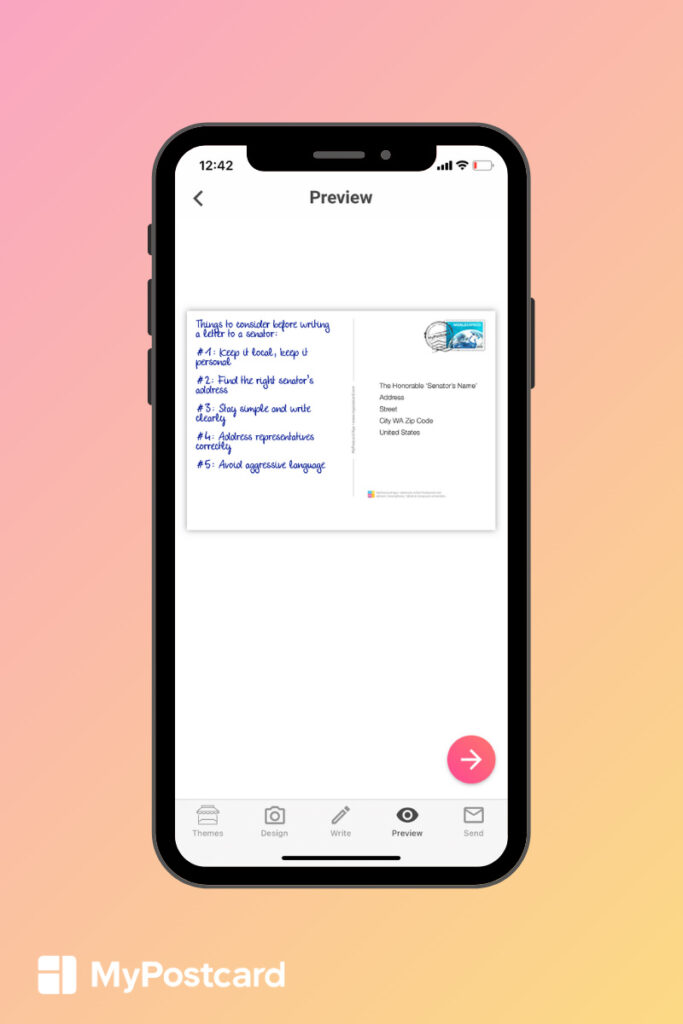Members of Congress get hundreds to thousands of communications per week. Senators receive letters, phone calls, faxes, emails – and postcards. Yes, political postcards. In fact, the Women’s March Organization set up a postcard campaign early in 2017. They offered unique postcards for people to use when writing a letter to a senator.
Well-planned messages sent by constituents give senators pause for thought. Many people are sending postcards, partly for cost-effectiveness.But also because postcards as opposed to letters can sometime be more powerful because of the visual message on the front of the cards underlining its message.
In fact, a 2017 article in the New York Times highlighted several high profile individuals and grassroots organizations that have used customized postcards as the delivery format when writing a letter to a senator.
What methods can I use to contact my representative?
Method #1: Download free templates for DIY printing
A lot of artwork for political postcards or letter templates is available as a free download. Political Action Committees (PAC) create and post templates on their websites. You will often find them on their social media sites as well. You can download and print them on your home printer. Check out Canva for professional looking free designs.
Another option is to use the pre-made templates as the base for create-your-own postcards that you design online and then pay to print professionally. There are dozens of print service websites you can choose from.
Method #2: Print and send online
The traditional method of sending postcards is to handwrite and sign your message. Online services like MyPostcard allow you to create your own postcard online and personalize them with text though, or to personalize political designs like these from the Democracy Delivered profile.
Check out the Postcards to Voters site where you can use MyPostcard’s service to send one of tons of powerful designs to a local reqpresentative.
If you have some of that downloadable artwork from an advocacy organization, you can apply that image to your layout. We will print AND send your postcards for you from anywhere in the world.
Method #3: Purchase letter stationary or postcards in store
Stationery makers are designing postcards specifically for writing a letter to a senator and other lawmakers. Several are selling the postcards at cost. Others are donating some of the proceeds to the relative charities. This trend of writing a letter to a senator and other representatives is growing.
5 Things to consider before writing a letter to a senator
Tip #1 Keep it local and personal
Senators want to hear from the people they serve. They represent the folks who elected them. Whether you voted for your senators or not, you are part of their constituency. Send letters and postcards only to the senators from your state or your own representative. You can personalize your message to identify yourself as a resident of the state.
When town hall meetings aren’t available
Of course, if you have the opportunity to meet with your senator in person, such as a public event or town hall meeting, all the better. When that is not an option, the next best thing is writing a letter to a senator.
While email is an instant option, a traditional letter or postcard may have more of an impact. Physical mail holds visible and literal weight. It demands greater attention than a full email inbox.
Personalizing letters vs. using boilerplates
Many people choose to send form letters to every member of the Senate. That proves less effective than a personalized letter to your senators. A short but targeted postcard is more effective than a generic form letter.
Writing a letter to your representative tip #2: Find the senator’s correct address
There are a few ways that you can find the addresses you need when writing a letter to a senator and house delegates. Each state has two senators. You can go to Senate.gov and navigate to the Senator’s tab.
The page lists email, phone number, and links to the website. The mailing address will be for their Washington D.C. office. It will also include the physical address for their local office.
You may choose to send copies of your letters to your house representatives as well. For those addresses, you need to determine which district is yours.
To do this, go to House.gov. Find “Find Your Representative” at the top of the page and enter your zip code. Sometimes you will need to enter your full address to determine your congressional district.
The representative’s official website should have all the contact information you need for writing a letter to a senator.
Writing a letter to a senator tip #3: Keep it simple and clear
You may have a laundry list of issues you’d like to address. However, your letter will be more effective if you address a single topic. A typed, single-page letter is the traditional approach. An abbreviated version on a postcard should have the same elements as a formal letter.
Your message should be respectful, have an objective tone, and stay on point. It should also contain specific details to support your claims.
Follow this simple, three-part letter format for best results:
State your purpose
Start with who you are and what the issue is that you are writing about. The goal is to identify yourself as a constituent, or resident of their state and district. If you voted or donated to their campaign, indicate this as well.
If you would like to receive a response, also include your full name and address, even if it already appears on the envelope.
Provide adequate detail
Summarize the issue. If you are writing about one bill in particular, be sure to name the full title and title number. Keep your tone professional and resist the impulse to be emotional. Whenever appropriate, include evidence or examples to back up your argument.
Identifying pertinent legislation
Your senators have full plates when it comes to legislation. Be sure you identify which bill or piece of legislation you are writing about. You should provide the official number, so they know which one you are referencing.
This also establishes credibility on your part for a) knowing your topic and b) being courteous enough to provide the recipient with the required information.
When writing a letter to a senator, present your information using these identifiers:
House Bills: “H.R._____”
House Resolutions: “H.RES._____”
House Joint Resolutions: “H.J.RES._____”
Senate Bills: “S._____”
Senate Resolutions: “S.RES._____”
Senate Joint Resolutions: “S.J.RES._____”
Request action
End your letter by calling for the action you want your senator to take. That may be a vote in favor of or against a piece of legislation. Or, it may be a change in policy, as long as you are specific in your request.
Writing a letter to a senator tip #4: Address members of congress correctly
Letters and postcards to your senator should be formal. There is a preferred way to address your letter. Below are the proper headers to you use when writing a letter to a senator, even if you are sending the letter via email.
Use these headers to begin your letter, filling in the appropriate name and addresses for your Congressperson.
Use this title for your senator:
The Honorable (full name)
(room #) (name) Senate Office Building
United States Senate
Washington, DC 20510
Dear Senator (last name):
Use this address for your state representative:
The Honorable (full name)
(room #) (name) House Office Building
United States House of Representatives
Washington, DC 20515
Dear Representative (last name):
Tip #5: Avoid doing this when writing a letter to a senator
You are no doubt passionate about the issues prompting you to write your senator. However:
Resist the urge to use language that could be potentially insulting.
You will be more effective if you write your message in a calm, logical tone. Obviously, avoid threatening language. It’s rude but also potentially problematic for you if staffers report your message. It also obscures your point and allows representatives to effectively dismiss your argument.
You can certainly request a response, but do not demand one. This is another rude gesture that will get in the way of your point.
Avoid boilerplate text. Many organizations offer your pre-written text to help people with their messages, including MyPostcard app. These are wonderful guides. However, you should personalize them rather than simply copy and pasting. The majority of your text should be in your own words.
Get ready to speak your mind
The First Amendment of the United States Constitution states that “Congress shall make no law respecting an establishment of religion, or prohibiting the free exercise thereof; or abridging the freedom of speech, or of the press; or the right of the people peaceably to assemble, and to petition the government for a redress of grievances.”
Writing a letter to a senator is an expected response to the issues that impact you as an American citizen. Hopefully, this article will be a helpful guide as you exercise your First Amendment right.
Remember to be respectful and clear in stating your purpose and requested response. Keep your communication short and to the point, especially when using the small space on the back of a postcard.
Please contact us if you have any questions about printing and sending your personalized postcards.




2 Comments
Lovely article! You are an accomplished writer. I, myself, seem to be an accomplished proofreader. In your bio at the end of the column, did you perhaps mean “than on a postcard,” rather than “then on a postcard?”
Hi Lee, you are indeed a fantastic proofreader – thank you for that! 😀
Best,
Maud